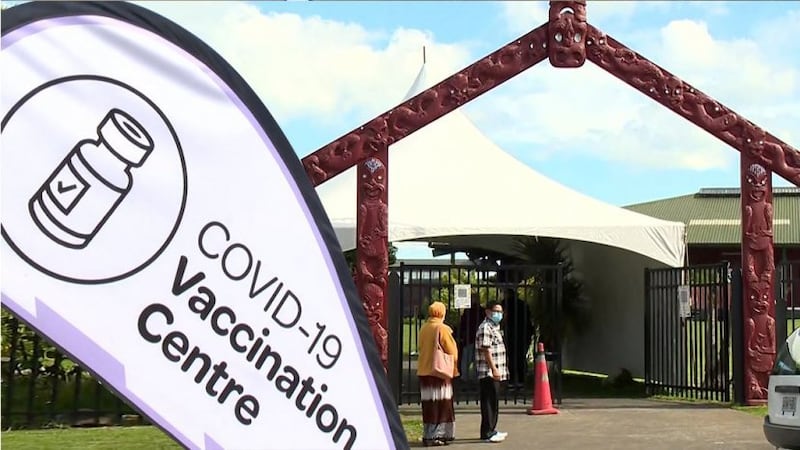My tupuna Heremia Te Wake was considered one of the last paramount chiefs in Hokianga. He was also one of the 2,500 Māori who died in the 1918 flu epidemic.
His daughter, Dame Whina Cooper, recalled the pain of those times.
“I remember we put him in a coffin, like a box. There were many others, you could see them on the roads, on the sledges, the ones that were able to drag them away, dragged them away to the cemetery. No time for tangi.”
The Māori death rate was seven times higher than that of non-Māori during the epidemic.
We're facing a similar tragedy today if the government doesn’t get it right in this pandemic.
Too many Māori and Pasifika are affected by Delta. Together they make up more than 80% of current Covid cases since the August outbreak.
Covid's welcome mat
Where influenza was indiscriminate in its victims, Covid selected the elderly and those with poor immunity. Then Delta emerged with more ruthless traits: quicker, sicker and younger.
Māori and Pacific Islanders were always going to be among the most vulnerable. We put out the welcome mat with our poor health and overcrowding in sub-standard homes. Low vaccination rates for both groups had the virus coming through the front door.
Yet the government has closed its door on an elimination strategy. It's come up with a new campaign, a target to vaccinate 90 per cent of all New Zealanders.
Māori and Pacific peoples are barely registering and the Prime Minister knows it.
"Those who haven't had a vaccine make up the vast majority of our cases," Jacinda Ardern scolded at a recent media briefing.
Government blind
"If we had a vaccination rate at 90 percent or above in either Hamilton or Raglan, level 3 restrictions would have been unlikely," she said.
But the government has failed to see that its approach for Māori and Pacific has rarely worked.
In 2020 during the first Covid lockdown, iwi fortunately had the resources to care for their people. It proved that a Māori model of care - from food parcels to iwi checkpoints - was proactive, organised and successful.
Lockdown and public health measures stamped out Covid and a tonne of money took care of the political, social and economic impact.
But, when it came to recognising the solutions Māori achieved, the government was like a Hokianga sand dune - unstable, changeable and slippery.
It chose to stay with a system that has abused Māori in various ways, including health disparities.
Where the buck stopped
Before Delta slipped in through trans-Tasman travel and popped our bubble, vaccination was already on the agenda. But the vulnerability of Māori and Pacific peoples was ignored in favour of an ad-hoc funding approach.
When our vaccination rates stayed stubbornly low, the government started to tell us off.
Māori MPs sounded like the uncles at the marae who growl at the 'young fullas' for not laying the hangi down properly.
Associate health Minister Peeni Henare admitted the lag in Māori vaccination was on the verge of"'a significant failure". But, he said, the buck stopped with Māori. He paused for a bit and went off to do some cheerleading for the new Māori Health Authority.
Māori Development Minister Willie Jackson claimed he didn't know what else he could do to make Māori get vaccinated. He threw up his hands, then threw some money at the problem - $38 million to support the mammoth effort of Māori health providers who'd been doing the hard yards.
By now, however, Māori had been crushed by weeks of crippling restrictions. Many simply didn't have the means to buy food, let alone the willpower to get tested or vaccinated.
Not a priority
Following a visit from the Prime Minister to the Wainuiomata Marae last week, Vaccination centre leader Teresea Olsen spoke of some grave realities for the community she served.
She posed the rhetorical question of why whānau would want to be vaccinated when violence is rampant in the household or when whānau are hungry… “it's not a priority,” she said.
Te Waipounamu Whānau Ora chief Helen Leahy said its $1m Covid fund ran out after more than 14,000 applications for help. Parents were going without kai. It was only when the kids started missing meals that the shame of asking for help was put aside. More than 60,000 people in the South Island got some short-term relief.
Now the drive to increase Māori vaccination rates is more urgent. There are vaccine buses, free taxis, marae-based clinics, 'max vax' iwi events, even prizes of iPads, PlayStation games and a trip to Rarotonga if you're fully vaccinated. It's Māori ingenuity finally funded by the government.
But I do wonder whether it was the extent of our exposure to the virus or the risk we posed to the general population that caused such generosity.
Now Auckland's Alert level three restrictions have been relaxed. People can connect with loved ones outdoors, enjoy walks or take kids to the park or send them off to kōhanga reo.
But our vaccination rates are still low. The infection will be hard to contain and track now there's more movement at level three in Auckland. The 'science', according to the government, shows the changes aren't likely to spread the virus because being outdoors and ventilation makes all the difference.
But it could be a death warrant for Māori and Pacific peoples, especially our young, unless the push to vaccinate takes hold. That's based on science too and historical evidence that we know better.
Māori mā, get vaccinated – the mass graves in our urupā should be an encouragement to do so

